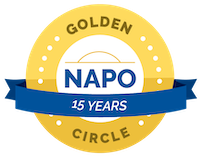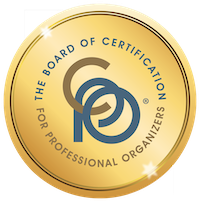Many hands make light work
I love leading organizing teams. The amount of work we can get done in a short period of time amazes me. Back in 2012, I wrote a blog post called Working with an organizing team that outlined some of the advantages of hiring an organizing team, rather than a single organizer. Eight years later, all of that is still true!
I’ve been leading teams since 2008. What started as something I did only occasionally has turned into the mainstay of my business. I stopped taking new one-on-one clients some years back (though I do work with individually with some legacy clients) and my team members sometimes work one-on-one with clients who prefer that slower, more deliberate approach. But the vast majority of Peace of Mind Organizing’s work is team organizing.
Here are a couple of pictures of a case in point. We were able to give this food professional back her workspace in just two (long) days. In addition to this main area, there was a large back area filled with boxes and bins. Sixty-five human hours were spent creating a decluttered and organized workspace. Obviously, if only one organizer were working, it would have taken weeks, instead of just a couple of days.
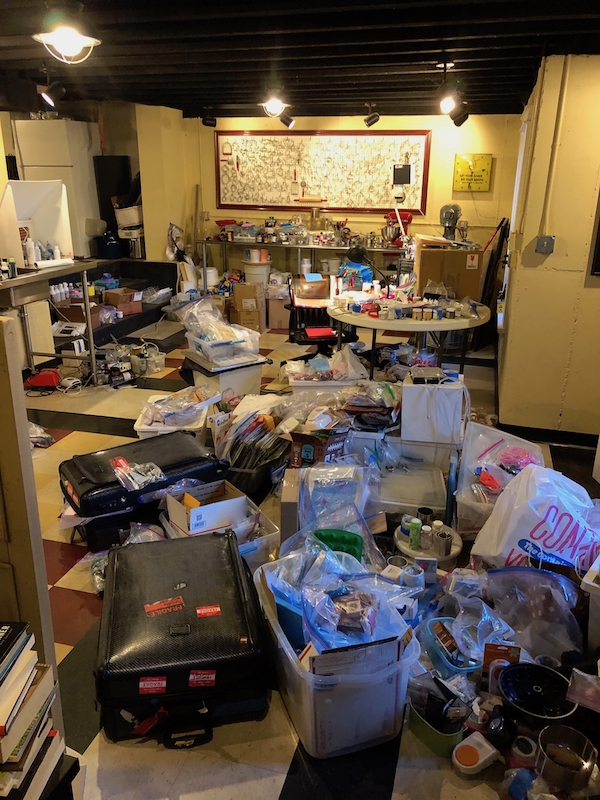
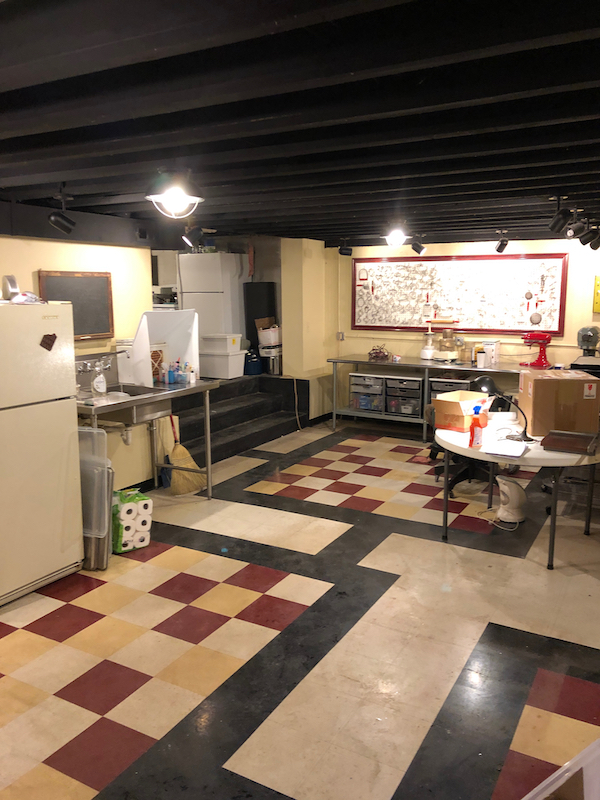
It is such rewarding work creating swift transformations for people who are able to let go of things quickly and whose budget allows for the up-front investment. My team members are talented and cheerful and full of compassion and good spirit. I feel so fortunate to be able to provide this service to my clients! You can learn more about the team organizing experience on the Operation: Peace of Mind page on this website.
Worth repeating (again): Decluttering old papers and memories
I spent the day yesterday working with a client on years of accumulated paper so this post, in which I discussed liberating myself of excess paper, resonated with me today. I wrote this post in October 2015 and have not missed a single piece of paper I let go of during that purge four and a half years ago!

Over the weekend, I faced down the challenging of decluttering a file cabinet full of old papers and memories. I love having these experiences that put me in my clients’ shoes and help me better understand what they’re going through.
A number of years ago, I moved my office four-drawer filing cabinet into the basement, replacing it in my office with an Elfa file cart. I didn’t bother decluttering the stuff that moved to the basement with the file cabinet. It was all papers related to achievements in my first two (and only) jobs, as well as administrative and project files from my decade as a dog writer, along with over 100 files of newspaper and magazine clippings of published articles I’d written.
They might have sat there until we moved, except that we’re doing a big repair and renovation in our basement, so the file cabinet has to be moved several times. It seems like a good time to (literally) lighten the load in that cabinet.
So I went to the basement and started going through the files. It was a fun and sometimes sad trip down memory lane. The tricky part was much of the material in that file cabinet pre-dated the worldwide web as we know it so isn’t available online (or at least not easily). I always caution people to give some thoughtful consideration to discarding irreplaceable items, but I also tell them that the more sentimental items they keep, the less value any of it has. So I was experiencing the push-me-pull-you of those two factors.
In the eighties, I worked for a non-profit on an international project that involved publishing magazine supplements in magazines around the world. I had a copy of each of those supplements. They really don’t have any value for me—in thirty years I’ve never once been asked about them. Yet they evoke some fond memories. (I traveled around the world and met those magazine editors.) And I don’t think they exist in digital form. What to do?
After a little thought, I decided to keep one of them and recycle the rest. That felt a little scary but also gave me that great feeling of lightening the load.
My next job was doing media relations for the Missouri Botanical Garden and I had kept some important clippings I’d placed. Back then I was able to garner some pretty significant attention for stories that felt like a very hard sell. Those clippings and the news releases I’d written to place them could be handy if I were every seeking a job in media relations. But the likelihood of that is close to nil. So I ended up keeping a little portfolio I’d created back then and recycling everything else.
Then I came to the more recent career—all the files from when I was a dog writer from 1995 to 2005, when I started Peace of Mind Organizing. I threw away all past project files, which was a pretty easy decision. Then I dealt with the clipping files. I wrote something like 150 articles and back in those pre-internet days one mailed photocopies of clippings with query letters to try to get magazine assignments. So I had made a bunch of copies of every article I published. Only laziness had stopped me from getting rid of the extras years ago. Yesterday, in the spirit of lightening the load, I kept one copy only of the more significant articles, like the ones that appeared in national magazines (I wrote quite a bit for Family Circle—that’s part of one of my favorite Family Circle articles in the photo above), the columns I wrote for a now-defunct magazine and a now-defunct website, and the articles for which I won awards. I went from hundreds of files to a single, fairly thick, file.
Going through this process was a great mental exercise. I got to revisit some achievements, which is always fun. I cried when I read the column I’d written after our dog, Scout, died in October 2001 and the one I wrote after our other dog, Kramer, died in December 2001. It made me appreciate, as I probably didn’t at the time, that those articles probably helped others who were grieving the loss of their pets. I’m glad I kept hard copies of those because they’d be tricky to find online.
Do you have ancient files or other memorabilia lurking somewhere in your house? I encourage you to bring them out into the light and go through them. You may jog some really fond memories. And you find it easier than you think to let go of this particular type of excess. Trust me, it can be liberating!
Screentime Genie can help you cut down on screen time

If you, like me, find yourself paying more attention to your computer and mobile devices than real life and non-digital activities, the geniuses at Stanford University, led by B.J. Fogg of Tiny Habits fame, have a free tool that can give you some tools to cut down on your screen time.
It’s called Screentime Genie. I’ve been following B.J. Fogg for years now so was delighted to receive an email about Screentime Genie. I’ve bought his new Tiny Habits book though I haven’t read it yet. I’ll be writing about it here after I do.
I tried out the Screentime Genie today, telling the tool that I wanted help in reducing time on Facebook. It asked me a couple of questions, then offered me about a half dozen potential tools to help me out. I selected three (setting an intentional background for my phone, downloading the HabitLab Chrome extension, and reducing notifications on my phone). The tool will check in with me in a week (via email) to see how it’s going. I love accountability, so that’s great.
If you’ve been looking for ways to cut down on your screen time, you might give it a try!
Worth repeating: Working during times of stress
I wrote this post 5.5 years ago when I was dealing with some health challenges for family members. It came to mind recently, because my oldest brother has taken ill and has been hospitalized in southeastern Washington state for the past three weeks. I was trying to maintain my work schedule in St. Louis while checking in on him but decided about two weeks into his illness that I needed to travel to Washington to be there for him and be his advocate. In rereading the post, I felt like it had a great message. Scott is recovering from his bouts with severe pneumonia and I know I’ll keep these strategies in mind as I go back home to St. Louis and try to support him from afar.

Since my schedule lightened up a couple of years ago, I’ve lived with relatively little stress. I work hard, which is occasionally stressful, but it’s good stress, since I love my clients and my work. Everything else has been on a pretty even keel. I know that I’m very fortunate.
But this month I’m facing some pretty serious health concerns for loved ones. And this morning my beloved standard poodle, Kirby, woke up not feeling well. We have a vet appointment this afternoon. (That’s him in the photo, on our friend’s porch.)
The worry is driving me to distraction. I know I can’t spend my time worrying because (a) it does no good and (b) I have stuff that needs to get done.
So I got to thinking about what I can do for myself to help me be productive, rather than just miserable, during these times of stress. Here’s what I came up with—maybe it will help you when you’re feeling stressed.
- Stick with my habits and make sure the basics get done. Luckily, my habits are pretty ingrained, so they’re getting done. Ignoring the laundry will get me nowhere, so there are clothes in the wash as I type. Letting my blog go unwritten is also not helpful, so here I am blogging.
- Have a good task list. A solid, realistic daily task list gives structure to my day and helps me know what to do next. (These days, I’m using TeuxDeux to keep track of tasks.)
- Know what’s important. I’m focusing on putting items on my task list that are both urgent and important. Now is probably not the time for me to launch new initiatives.
- Write everything down. My memory isn’t great anyway, but when I’m stressed out it’s really bad. I don’t want to worry about forgetting something, so I’m writing things down, primarily in Evernote (except tasks, which are going in TeuxDeux).
- Distract myself with some fun stuff. I’m trying to keep my daily task list short, leaving me some time to immerse myself in enjoyable, productive endeavors, like knitting, reading or genealogy research.
- Avoid mindless internet or channel surfing. It’s so easy to get on Facebook and lose a half hour (or more) watching dumb videos. That can be mercifully mind-numbing, but also completely unproductive. I’m trying to avoid that by consulting my task list and staying away from Facebook. But I do allow myself the occasional Facebook break—which I keep in check with the help of a timer.
- Practice self care. I’m always urging my clients to take care of themselves and not put everyone else’s needs before their own. That’s something that’s important for me to remember right now.
If all goes well, the majority of the health concerns should be over in about six weeks (shorter for Kirby, I hope!), so this is short term. I can’t put my life and work on hold for six weeks but I can practice the above coping mechanisms.
It's okay to break the chain
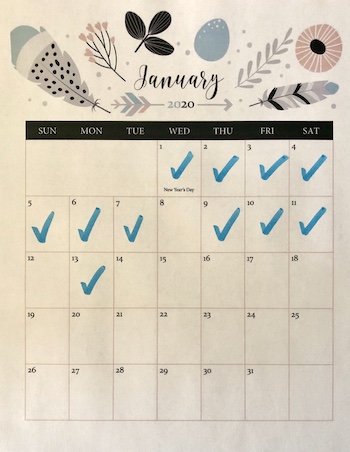
January is a great time for people to try to create new habits or to take up 30-day challenges. Right now I have two 30-day things I’m trying to do: Yoga with Adriene’s 30-day journey called Home which is absolutely wonderful. I’m loving it. The other is my own 30 × 30 challenge on my blog Organize Your Family History, in which participants commit to doing 30 minutes of genealogy research every day for 30 days. In addition, I’m trying to create the daily habit of dealing with finances through You Need a Budget and Quickbooks. (FYI, that YNAB link is an affiliate link, which means I get a free month if you click on it and sign up after your free trial.)
I’ve blogged here before about the value of the Don’t Break the Chain concept where when you do something for a few days in a row it you don’t want to break the chain. The flip side of that, though, is that sometimes when you do break the chain, you abandon the practice all together.
But it doesn’t have to be that way. I’ve been reflecting on that because with my yoga practice I’ve missed two sessions so far this month. My practice wasn’t interrupted by my trip to Walla Walla, because I double up on sessions the day before each day of flying. (It takes an entire day of travel to get to or from Walla Walla.) But last week I had a seven-hour organizing session that, while rewarding, left me wiped out. So I gave myself permission to not do yoga that day. And then yesterday I had limited time due to social commitments. I thought I would do yoga later in the evening, but I got home later than expected. When did get home Bix had a serious need to play so I let go of the idea of yoga last night.
But I’m not calling that a failure. You can bet that yoga was on the priority list today and I will finish the 30-day journey on February 2, rather than January 31. No big deal. It doesn’t mean I can’t keep a commitment. It just means that I prioritized something different those days. With my 30 × 30 challenge, I have managed to do a little research every day, but it has not been the full 30 minutes. I am hopeful that by month’s end I’ll average 30 minutes a day, but I am feeling great about my daily effort.
My point is this: Daily effort and 30-day challenges are great. But if you miss a day, don’t let it shake you off your path. Breaking the chain doesn’t mean you failed or are incapable of doing the thing every day. It doesn’t mean you can’t create great habits. It just means that the next day you might want to make doing the thing a priority. It’s okay to break the chain, particularly if you get right back on your path.
(The lovely printable calendar above came from PlanYourTasks.com)
Do you have a word of the year?
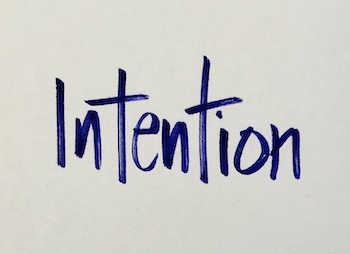
Every year during end-of-the-year planning time, I select a word of the year. I typically use Christine Kane’s Your Word of the Year Discovery Tool but this year I used the Power Sheets Intentional Goal Planner from Lara Casey of Cultivate Your Life to help me set my 2020 goals and decide on a word of the year.
My 2020 word of the year is Intention.
What’s the value in having a word of the year? It can serve as a filter through which you make decisions throughout the year. It can be reminder of your goals and your hopes for the year. In short, it can keep you on track.
Another benefit of having a single word of the year is that it’s easy to make a reminder so you don’t forget it. A note on your bulletin board or refrigerator. A periodic one-word reminder on your phone. Heck, you can change your lock screen to display your word in a lovely font. The year that my word of the year was Fearless, I had a bracelet made with that word from My Intent.
If you don’t have a word of the year, I encourage you to consider trying it. And if you do have one, feel free to share it in the comments!
Worth repeating: Decluttering is like exercising
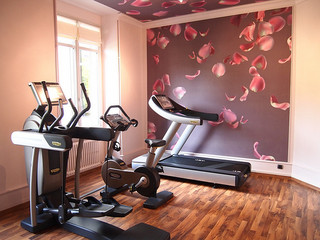
I first published this post in 2014. Back then I belonged to a gym. Nowadays, most of my exercise (aside from walking my dog and working with my clients) involves doing at-home yoga. And the similarities still resonate with me!
I’ve had my struggles with getting myself to exercise over the years and I’ve detailed some of them on this blog. The bottom line for me is that I’m pretty fit and pretty slender without going to the gym, so getting myself to go has been challenging, since I don’t enjoy it that much.
But now that I’m past 50, it feels like more of an imperative. I know that regular exercise will help me age more gracefully and healthily. I know that it will help stave off osteoporosis, which runs in my family. I know that it might help with the fact that my stomach is no longer perfectly flat. (Certainly, not exercising isn’t going to help with that!)
So I’m trying to make exercise a priority. But it’s not easy because I’m very busy with work. And did I mention I don’t enjoy it that much?
Back in October 2013 I joined a gym, the tiny exercise studio called Take Action just a couple of blocks from my home. The membership and some personal training sessions with Take Action owner Jeanna Jackson were a (requested) 50th birthday gift from my husband. At that time, I discovered the similarities between personal trainers and professional organizers.
So the other day, as I was going through my exercise routine—created for me by Jeanna—I got to thinking once again about how exercising for people like me is like decluttering for folks struggling with clutter. I’ve already mused here about the how both decluttering and exercising get easier with practice. But more recently, I’ve been thinking about these similarities:
- You might not feel like doing it, but afterward you’re glad you did
- It can be hard to find the time
- Both decluttering and exercising can be easier to do when you have company (and/or guidance)
- You may not see instant results, but little by little you see progress
- Any effort at all is worthwhile
- You’re frequently struck by inspiration while exercising and while decluttering/organizing
- Both can become habits
When I look around my house and see the progress I’ve made over the years in keeping order despite being a naturally messy person, I know I can make progress in with exercise. I’m working on focusing on the benefits and making it a priority. I hope one day soon to make exercising a natural part of my day just as certain habits for keeping order (like clearing off my desk every day) have become habits.
Photo by Hotel de la Paix Geneve via Flickr.
Links
- Getting to Good Enough podcast
- National Association of Productivity and Organizing Professionals
- Ravelry
- Peace of Mind Spending
- Institute for Challenging Disorganization
- Shannon Wilkinson, life coach
- Are you interested in becoming a professional organizer?
- Organize Your Family History
- NAPO St. Louis





